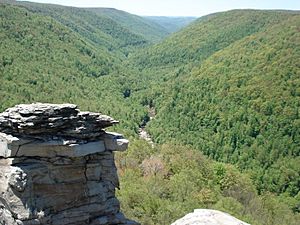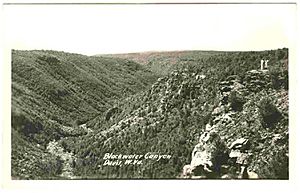Blackwater Canyon facts for kids
The Blackwater Canyon is a deep, wild gorge in the Allegheny Mountains of eastern West Virginia, USA. It's about eight miles (13 km) long and was carved by the Blackwater River. For many years, people have debated its future. Some want to protect its natural beauty, while others have wanted to use it for industries like power, logging, or building.
Contents
What is Blackwater Canyon Like?
The Canyon starts at the bottom of Blackwater Falls, near the town of Davis. It ends where the Blackwater River meets Dry Fork. This meeting forms the Black Fork, near the town of Hendricks.
The Canyon is a huge ditch, about 1,000 feet (300 meters) deep. It separates two mountains: Backbone Mountain on one side and Canaan Mountain on the other. From the falls (915 meters high) to where the rivers meet (534 meters high), the river drops about 1,250 feet (380 meters). This big drop makes it a great place for kayaking, with exciting rapids! Smaller streams like Pendleton Creek and Shay's Run also flow into the Canyon, creating cool "hanging valleys" high above the river.
Animals and Plants in the Canyon
The land around the Canyon covers about 6,000 acres (24 square kilometers). It's mostly a second-growth forest, meaning the trees grew back after being cut down long ago. You'll find spruce, hemlock, and pine trees here. There are also oak, maple, yellow poplar, and rhododendron plants.
Many animals call the Canyon home. You might see black bears, white-tail deer, squirrels, and many types of birds. The Canyon also has dens for timber rattlesnakes. In spring and summer, lots of wildflowers bloom, like soapwort and jewelweed.
Trails and Views in the Canyon
The old railroad tracks of the Western Maryland Railway, which once ran through the Canyon, are now a hiking trail. It's called the Blackwater Canyon Railroad Grade Trail (or USFS Trail 115). This trail is about 12.2 miles (19.6 km) long. As you walk down the Canyon trail, you'll cross old stone tunnels called culverts. These offer amazing views of smaller waterfalls from streams like Tub Run, Big Run, and Flatrock Run.
There are also other trails. The Canyon Rim Trail (USFS Trail 117) is on the edge of the Canyon, offering great views like the Big Run Overlook. The Limerock Trail (USFS Trail 142) slowly goes down into the Canyon over about 4 miles (6.4 km).
History of Blackwater Canyon
Early Discoveries (1800s)
For a long time, the "High Allegheny" region, including Blackwater Canyon, was mostly wild. It wasn't until the mid-1800s that more people learned about it. In 1853, a writer named Philip Pendleton Kennedy wrote about his trip to the remote gorge. Two years later, an artist and writer named David Hunter Strother wrote a story called "The Virginia Canaan" for Harper's Monthly. He described huge spruce and hardwood trees, thick laurel and rhododendron bushes, and a wild, powerful river carving the Canyon.
In 1881, a rich businessman named Henry Gassaway Davis started building a railroad in eastern West Virginia. By 1884, the railroad reached the new town of Thomas. In 1888, Davis decided to extend the railroad through the tough Blackwater Canyon to Hendricks. This was a huge challenge! Workers had to dig deep cuts into Backbone Mountain. To cross streams and ravines, they built giant stone arches and culverts. The most impressive one is at Big Run. It's about 60 feet (18 meters) long, 25 feet (7.6 meters) wide, and 30 feet (9.1 meters) high. Trains sometimes had accidents here because of the sharp curve.
Changes in the 1900s
The railroad, later taken over by the Western Maryland Railroad, brought a lot of industry to the area. Towns like Douglas, Limerock, and Coketon grew as coal mines, coke ovens, and logging businesses brought many workers.
However, this growth caused a lot of damage to the environment. Much of Tucker County, including the Canyon, was completely cut down. The leftover wood and branches made the area very dry and prone to fires. By 1910, huge fires swept through the land, sometimes burning from spring until the first snow. In 1914, with almost no trees left in the Canyon, the ground burned for six months straight. After the fires, only thin soil and bare rock remained. This led to soil washing away and floods, making the area less populated. Since 1914, large-scale logging has not happened in the Canyon again.
In 1920, the Monongahela National Forest (MNF) was created. This brought new hope, with projects to stop erosion and help the forest grow back. The south side of the Canyon was owned by a power company and was planned for a big hydroelectric project, so it wasn't part of the MNF at first. But because of the nearby protected lands, the Canyon slowly started to recover, and healthy new forests grew.
During 1943 and 1944, the rugged cliffs of the Canyon were used by the U.S. Army for mountain climbing training. This helped prepare soldiers for fighting in the mountains of Europe during World War II.
From the 1930s to the 1950s, parts of the Canyon were given or leased to the state. This led to the creation and expansion of the Blackwater Falls State Park (BFSP) in 1937. The park, which includes the famous 62-foot (19-meter) falls, is at the head of the Canyon. Plans to build a dam in the Canyon never happened. This meant more people could enjoy the area for recreation. However, the lower part of the Canyon remained uncertain for many years – it wasn't fully protected, but it also wasn't developed.
In 1970, the National Park Service suggested the Canyon become a National Natural Landmark. The railroad stopped running in 1983, and six years later, it became a hiking trail. In 1995, the U.S. Forest Service suggested the Blackwater River become a Wild and Scenic River.
For two years, a group called The Conservation Fund tried to buy the Canyon land from the power company so it could become part of the MNF. But in 1997, the power company sold its 2,750-acre (11 square kilometer) tract to a private developer for $5 million. This developer then sold it to Allegheny Wood Products (AWP), a company that exports wood. AWP started cutting trees in the lower Canyon and planned some building sites. People worried about losing the natural beauty and history. So, AWP started working with government groups to help protect the area.
In 2000, the state bought the famous Lindy Point overlook. This was added to Blackwater Falls State Park, giving everyone access to one of the most beautiful views of the Canyon. AWP also agreed to give the state the first chance to buy more land in the Canyon in the future.
What is the Canyon Like Today?
Today, outside of Blackwater Falls State Park, about half of the land around the Canyon is owned by AWP, and about half is owned by the MNF. AWP has suggested cutting trees in a careful way on its land. However, environmental groups want the entire Canyon to be fully protected as a natural area. AWP also asked the Forest Service for permission to use the old railroad trail as a road for logging trucks.
- In January 2008, West Virginia Governor Joe Manchin suggested the state contribute $5 million to buy Blackwater Canyon. His goal was to protect this beautiful area from development.
- On July 30, 2010, the Forest Service made a decision about AWP's request to use the Blackwater Canyon Rail Trail. They said AWP could use the trail temporarily for maintenance and safety, but not for logging.




